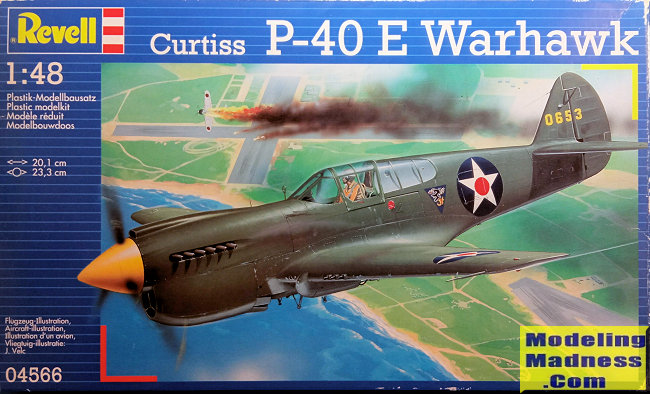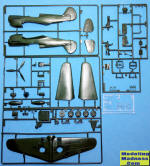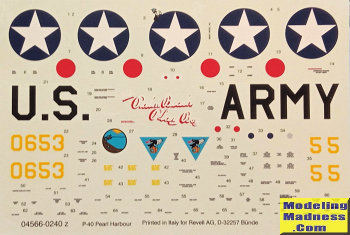
Revell 1/48 P-40E Warhawk
| KIT #: | 04566 |
| PRICE: | $15.00 when new |
| DECALS: | Two options |
| REVIEWER: | Spiros Pendedekas |
| NOTES: | Updated kit of the original 1978 mold, including extra/reworked parts |

| HISTORY |
In order to improve the P-40B/C series, Curtiss first developed the P-40D, featuring a new, larger Allison engine, a slightly narrower fuselage, redesigned canopy, improved cockpit and elimination of the nose-mounted .50 in (12.7 mm) guns, having instead a pair of same guns in each wing. The distinctive chin air scoop grew larger to provide sufficient cooling to the larger Allison engine.
Less than 50 P-40 Ds were built, as they were superseded by the very similar P-40E, featuring a slightly more powerful engine and an extra .50 in (12.7 mm) gun in each wing, bringing the total to six. Some aircraft also had small underwing bomb shackles.
The P-40E, supplied to the Commonwealth air forces as the Kittyhawk Mk IA, was the variant that bore the brunt of air-to-air combat by the type in the key period of early to mid 1942.
| THE KIT |
 Revell
first came in 1978 with this kit, reboxing it every year till 1983. Upon the
company’s merging with Monogram, the kit was reboxed again as a Pro Modeler
version in 1996, featuring reworked sprues, but also an extra sprue that
contained either updated or extra detailing parts (Instrument panel, cockpit and
main bays sidewalls, seat cushions, two nice Monogram figures etc).
Revell
first came in 1978 with this kit, reboxing it every year till 1983. Upon the
company’s merging with Monogram, the kit was reboxed again as a Pro Modeler
version in 1996, featuring reworked sprues, but also an extra sprue that
contained either updated or extra detailing parts (Instrument panel, cockpit and
main bays sidewalls, seat cushions, two nice Monogram figures etc).
Last reboxing of
the kit took place in 2001 under the Revell logo, featuring the Pro Modeler
molds and Cartograf decals. This kit is the subject of this review, bought in
2005 from my then usual, now closed, beloved toy/hobby shop in my hometown,
Halkis, Greece at the fair price of around $15.
The kit comes in the standard quite sturdy side opening Revell blue box,
featuring a very nice box art of artist J. Velc, depicting a 24 PG bird having
downed a Zero over Nichols Field, Philippines on & December 1941. Upon opening
the box, I was greeted with 59 dark green styrene pieces arranged in four
equally sized sprues. Shapes of parts look in general correct, though it has
been reported that the vertical stabilizer is bigger than it should be (maybe
the rudder chord is longer, but I will leave that to the P-40 Experten). Panel
lines are all raised and quite finely done, including a good amount of rivets
found at the real plane. Molding is good with little flash.
Cockpit is sufficiently detailed, containing all basic stuff found at the real
plane, including busy looking sidewalls. Same for the landing gear, where I was
pleasantly surprised to see brake lines molded onto the gear legs. The main bays
are fully closed and the wheels are weighted, though, to my eye, the weighted
effect is tad more pronounced than it should and you might consider reducing it
with some sanding. The distinctive chin triple inlet is also well done, as is
the prop and the exhausts (two styles are provided).
Transparencies are well molded and crystal clear with well defined frames.
Instructions are the typical 2000 era nice Revell ones, coming in the form of a
12-page two sided A4 b/w booklet, containing a short history of the type
together with a photo of an assembled model, a parts diagram and a color list.
The construction itself is spread in 33 simple and concise steps, with full
color callouts given where applicable.
 Two schemes
are provided, for a 24PG bird, as it stood in Nicholls Field, Philippines, in
December 1941 and for Cpt Barnett’s bird of 49FG, as it stood in Port Moresby,
New Guinea in April 1942. Both camos are identical with OD topsides over neutral
gray, differing only in the prop hub color and markings. Colors are given in
Revell codes, but also in generic form. Decals are superbly printed by Cartograf
and, though already more than 20 years old as of the time of this writing
(2023), look usable. Of note is that the fin code #0653 depicted in the box art
seems to belong to the other decal scheme, Cpt Barnett’s bird. It is correctly
printed at the instructions, though.
Two schemes
are provided, for a 24PG bird, as it stood in Nicholls Field, Philippines, in
December 1941 and for Cpt Barnett’s bird of 49FG, as it stood in Port Moresby,
New Guinea in April 1942. Both camos are identical with OD topsides over neutral
gray, differing only in the prop hub color and markings. Colors are given in
Revell codes, but also in generic form. Decals are superbly printed by Cartograf
and, though already more than 20 years old as of the time of this writing
(2023), look usable. Of note is that the fin code #0653 depicted in the box art
seems to belong to the other decal scheme, Cpt Barnett’s bird. It is correctly
printed at the instructions, though.
Instructions want you to first assemble the cockpit, then choose the exhausts
style and attach them from the insides of the fuselage. The triple chin inlet is
next assembled and trapped between the fuselage halves, followed by the cockpit
that has to be slipped in from underneath. The main wing is then assembled and
attached, followed by the tail planes, landing gear, wing tank, prop and
transparencies, ending a straightforward, uncomplicated build.
| CONCLUSIONS |
Though superseded
by newer offerings, this looks to be a decent kit of the P-40E. For sure its old
school origins with the raised panel lines and rivets and overall “softness”cannot
be hidden, (though the raised detail might in some cases be more “correct”).
In this latest reincarnation with the updated and extra parts, the kit offers a
relatively detailed cockpit and the same can be said for the other key areas of
landing gear and bays. General shapes of parts look correct (except, maybe, from
the rudder size, something that might be dealt with some judicious sanding-off),
transparencies are great, instructions are nice and decals are superb. Parts
count is not high and construction itself looks uncomplicated, deeming this kit
suitable even for less experienced modelers.
Still not that difficult to find and offered at very sensible prices, this is a
kit worth tackling.
Happy Modeling!
Spiros Pendedekas
September 2023
Copyright ModelingMadness.com. All rights reserved. No reproduction in part or in whole without express permission.
If you would like your product reviewed fairly and fairly quickly, please contact the editor or see other details in the Note to Contributors.
Back to the Main Page Back to the Review Index Page Back to the Previews Index Page